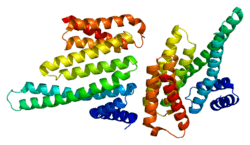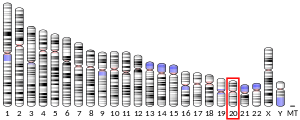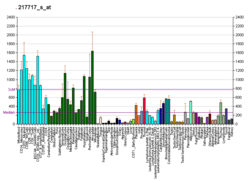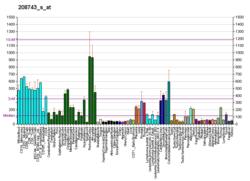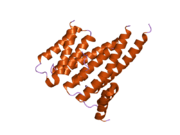YWHAB
14-3-3 protein beta/alpha is a protein that in humans is encoded by the YWHAB gene.[5]
Function
This gene encodes a protein belonging to the 14-3-3 family of proteins, members of which mediate signal transduction by binding to phosphoserine-containing proteins. This highly conserved protein family is found in both plants and mammals. The encoded protein has been shown to interact with RAF1 and CDC25 phosphatases, suggesting that it may play a role in linking mitogenic signaling and the cell cycle machinery. Two transcript variants, which encode the same protein, have been identified for this gene.[6]
Interactions
YWHAB has been shown to interact with:
gollark: ++tel rdial
gollark: ++tel graph
gollark: Oh dear.
gollark: ++tel graph
gollark: Okay, heavserver external communications and APIONET isolated.
See also
References
- GRCh38: Ensembl release 89: ENSG00000166913 - Ensembl, May 2017
- GRCm38: Ensembl release 89: ENSMUSG00000018326 - Ensembl, May 2017
- "Human PubMed Reference:". National Center for Biotechnology Information, U.S. National Library of Medicine.
- "Mouse PubMed Reference:". National Center for Biotechnology Information, U.S. National Library of Medicine.
- Tommerup N, Leffers H (June 1996). "Assignment of the human genes encoding 14,3-3 Eta (YWHAH) to 22q12, 14-3-3 zeta (YWHAZ) to 2p25.1-p25.2, and 14-3-3 beta (YWHAB) to 20q13.1 by in situ hybridization". Genomics. 33 (1): 149–50. doi:10.1006/geno.1996.0176. PMID 8617504.
- "Entrez Gene: YWHAB tyrosine 3-monooxygenase/tryptophan 5-monooxygenase activation protein, beta polypeptide".
- Ewing RM, Chu P, Elisma F, Li H, Taylor P, Climie S, McBroom-Cerajewski L, Robinson MD, O'Connor L, Li M, Taylor R, Dharsee M, Ho Y, Heilbut A, Moore L, Zhang S, Ornatsky O, Bukhman YV, Ethier M, Sheng Y, Vasilescu J, Abu-Farha M, Lambert JP, Duewel HS, Stewart II, Kuehl B, Hogue K, Colwill K, Gladwish K, Muskat B, Kinach R, Adams SL, Moran MF, Morin GB, Topaloglou T, Figeys D (2007). "Large-scale mapping of human protein-protein interactions by mass spectrometry". Mol. Syst. Biol. 3: 89. doi:10.1038/msb4100134. PMC 1847948. PMID 17353931.
- Qiu W, Zhuang S, von Lintig FC, Boss GR, Pilz RB (October 2000). "Cell type-specific regulation of B-Raf kinase by cAMP and 14-3-3 proteins". J. Biol. Chem. 275 (41): 31921–9. doi:10.1074/jbc.M003327200. PMID 10931830.
- Conklin DS, Galaktionov K, Beach D (August 1995). "14-3-3 proteins associate with cdc25 phosphatases". Proc. Natl. Acad. Sci. U.S.A. 92 (17): 7892–6. doi:10.1073/pnas.92.17.7892. PMC 41252. PMID 7644510.
- Yuryev A, Wennogle LP (February 2003). "Novel raf kinase protein-protein interactions found by an exhaustive yeast two-hybrid analysis". Genomics. 81 (2): 112–25. doi:10.1016/S0888-7543(02)00008-3. PMID 12620389.
- Truong AB, Masters SC, Yang H, Fu H (November 2002). "Role of the 14-3-3 C-terminal loop in ligand interaction". Proteins. 49 (3): 321–5. doi:10.1002/prot.10210. PMID 12360521.
- Van Der Hoeven PC, Van Der Wal JC, Ruurs P, Van Dijk MC, Van Blitterswijk J (January 2000). "14-3-3 isotypes facilitate coupling of protein kinase C-zeta to Raf-1: negative regulation by 14-3-3 phosphorylation". Biochem. J. 345 (2): 297–306. doi:10.1042/0264-6021:3450297. PMC 1220759. PMID 10620507.
- Yuryev A, Ono M, Goff SA, Macaluso F, Wennogle LP (July 2000). "Isoform-specific localization of A-RAF in mitochondria". Mol. Cell. Biol. 20 (13): 4870–8. doi:10.1128/MCB.20.13.4870-4878.2000. PMC 85938. PMID 10848612.
- Vincenz C, Dixit VM (August 1996). "14-3-3 proteins associate with A20 in an isoform-specific manner and function both as chaperone and adapter molecules". J. Biol. Chem. 271 (33): 20029–34. doi:10.1074/jbc.271.33.20029. PMID 8702721.
- Han DC, Rodriguez LG, Guan JL (January 2001). "Identification of a novel interaction between integrin beta1 and 14-3-3beta". Oncogene. 20 (3): 346–57. doi:10.1038/sj.onc.1204068. PMID 11313964.
- Mils V, Baldin V, Goubin F, Pinta I, Papin C, Waye M, Eychene A, Ducommun B (March 2000). "Specific interaction between 14-3-3 isoforms and the human CDC25B phosphatase". Oncogene. 19 (10): 1257–65. doi:10.1038/sj.onc.1203419. PMID 10713667.
- Robertson H, Langdon WY, Thien CB, Bowtell DD (November 1997). "A c-Cbl yeast two hybrid screen reveals interactions with 14-3-3 isoforms and cytoskeletal components". Biochem. Biophys. Res. Commun. 240 (1): 46–50. doi:10.1006/bbrc.1997.7608. PMID 9367879.
- Yu T, Robb VA, Singh V, Gutmann DH, Newsham IF (August 2002). "The 4.1/ezrin/radixin/moesin domain of the DAL-1/Protein 4.1B tumour suppressor interacts with 14-3-3 proteins". Biochem. J. 365 (Pt 3): 783–9. doi:10.1042/BJ20020060. PMC 1222735. PMID 11996670.
- Grozinger CM, Schreiber SL (July 2000). "Regulation of histone deacetylase 4 and 5 and transcriptional activity by 14-3-3-dependent cellular localization". Proc. Natl. Acad. Sci. U.S.A. 97 (14): 7835–40. doi:10.1073/pnas.140199597. PMC 16631. PMID 10869435.
- O'Kelly I, Butler MH, Zilberberg N, Goldstein SA (November 2002). "Forward transport. 14-3-3 binding overcomes retention in endoplasmic reticulum by dibasic signals". Cell. 111 (4): 577–88. doi:10.1016/S0092-8674(02)01040-1. PMID 12437930.
- Zheng Q, Yin G, Yan C, Cavet M, Berk BC (March 2004). "14-3-3beta binds to big mitogen-activated protein kinase 1 (BMK1/ERK5) and regulates BMK1 function". J. Biol. Chem. 279 (10): 8787–91. doi:10.1074/jbc.M310212200. PMID 14679215.
- Zhang SH, Kobayashi R, Graves PR, Piwnica-Worms H, Tonks NK (October 1997). "Serine phosphorylation-dependent association of the band 4.1-related protein-tyrosine phosphatase PTPH1 with 14-3-3beta protein". J. Biol. Chem. 272 (43): 27281–7. doi:10.1074/jbc.272.43.27281. PMID 9341175.
- Cavet ME, Lehoux S, Berk BC (May 2003). "14-3-3beta is a p90 ribosomal S6 kinase (RSK) isoform 1-binding protein that negatively regulates RSK kinase activity". J. Biol. Chem. 278 (20): 18376–83. doi:10.1074/jbc.M208475200. PMID 12618428.
- Toshima JY, Toshima J, Watanabe T, Mizuno K (November 2001). "Binding of 14-3-3beta regulates the kinase activity and subcellular localization of testicular protein kinase 1". J. Biol. Chem. 276 (46): 43471–81. doi:10.1074/jbc.M104620200. PMID 11555644.
- Wang Y, Jacobs C, Hook KE, Duan H, Booher RN, Sun Y (April 2000). "Binding of 14-3-3beta to the carboxyl terminus of Wee1 increases Wee1 stability, kinase activity, and G2-M cell population". Cell Growth Differ. 11 (4): 211–9. PMID 10775038.
Further reading
- Kino T, Pavlakis GN (2004). "Partner molecules of accessory protein Vpr of the human immunodeficiency virus type 1". DNA Cell Biol. 23 (4): 193–205. doi:10.1089/104454904773819789. PMID 15142377.
- Kino T, Chrousos GP (2004). "Human immunodeficiency virus type-1 accessory protein Vpr: a causative agent of the AIDS-related insulin resistance/lipodystrophy syndrome?". Ann. N. Y. Acad. Sci. 1024: 153–67. doi:10.1196/annals.1321.013. PMID 15265780.
- Calinisan V, Gravem D, Chen RP, Brittin S, Mohandas N, Lecomte MC, Gascard P (2006). "New insights into potential functions for the protein 4.1 superfamily of proteins in kidney epithelium". Front. Biosci. 11: 1646–66. doi:10.2741/1911. PMID 16368544.
This article is issued from Wikipedia. The text is licensed under Creative Commons - Attribution - Sharealike. Additional terms may apply for the media files.
